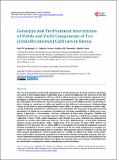| dc.description.abstract | The tea crop provides income and employment to rural populations in many countries. In Kenya, tea, which is the leading export commodity crop, is grown in highlands east and west of the Rift Valley at altitudes ranging from 1300 m to 2700 m above mean sea level. Variable responses of tea genotypes to different environments have been demonstrated. This affects the growth, productivity, and quality of tea. However, most tea husbandry practices are uniform across tea growing regions leading to variations in yields and quality in the different environments. Understanding causes of variations in tea growth parameters and yields to varying environments is vital to optimizing husbandry practices for maximization of productivity. The responses in growth and yield parameters of clonal tea to locations of production and their contribution to yields were compared. A genotype × environment trial was conducted in three sites (Kangaita, Timbilil and Kipkebe). At each site, a trial comprising 20 cultivars was laid in a randomized complete design replicated 3 times. Yields, yield components and climatic data were collected then subjected to analysis of variance and regression analysis. There were significant (p ≤ 0.05) yield variations between clones and locations. Yields ranged from 5162 kg mt/ha on clone TRFK 303/577 at Kipkebe to 935 kg mt/ha/year on clone TRFK 7/3 in Kangaita, surpassing the maximum variation possible postulated in earlier studies. The responses of the tea yield components to weather parameters varied with genotypes and environments. Shoot growth rates in Timbilil (r = 0.476)) and shoot density (Kangaita (r = 0.652) significantly (p ≤ 0.05)) correlated with yields. Yield components and weather parameters contribution to the total yield also varied with locations. The variations demonstrated that not all yield components can be used universally as yield indicators for clonal selection in different locations. For optimal production, selected tea clones should therefore be tested before adoption for commercial planting in other locations. | en_US |

